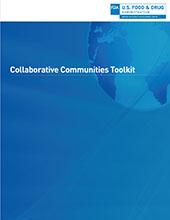Collaborative Communities: Addressing Health Care Challenges Together
In the medical device ecosystem, collaborative communities bring together stakeholders to achieve common outcomes, solve shared challenges, and leverage collective opportunities. At the FDA, the Center for Devices and Radiological Health (CDRH) believes collaborative communities can contribute to improvements in areas affecting patients and health care in the United States. Accordingly, participation in collaborative communities was one of CDRH's strategic priorities for 2018-2020.
CDRH encourages interested stakeholders to learn more about collaborative communities and review the toolkit, which provides a collection of helpful ideas to foster strong collaborative communities that are well-prepared to take on health care challenges.
On this page:
- Collaborative Communities with CDRH Participation
- What Is a Collaborative Community?
- Members of a Collaborative Community
- Considerations for CDRH Participation in a Collaborative Community
- Collaboration Communities Toolkit
- Frequently Asked Questions
- Contact
Collaborative Communities with CDRH Participation
The FDA currently participates as a member of these collaborative communities, which have been established and are managed and controlled by external stakeholders.
- Collaborative Community on Ophthalmic Imaging
- National Evaluation System for health Technology Coordinating Center (NESTcc) Collaborative Community
- Standardizing Laboratory Practices in Pharmacogenomics Initiative (STRIPE) Collaborative Community
- International Liquid Biopsy Standardization Alliance (ILSA)
- Case for Quality Collaborative Community
- Heart Valve Collaboratory (HVC)
- Wound Care Collaborative Community
- Pathology Innovation Collaborative Community (PICC)
- RESCUE (REducing SuiCide Rates Amongst IndividUals with DiabEtes) Collaborative Community)
- MedTech Color Collaborative Community
- Digital Health Measurement Collaborative Community (DATAcc)
- AI Global Healthcare Initiative Collaborative Community
- Infection Management Collaborative Community
- SHIELD Collaborative Community
- OpenOximetry Collaborative Community
- The Implantable Brain Computer Interface Collaborative Community (iBCI-CC)
- Smart and Autonomous Medical Systems (SaAMS) Collaborative Community
- Kilmer Community on Sterility Assurance
What Is a Collaborative Community?
A collaborative community is a continuing forum in which private- and public-sector members, which can include the FDA, work together on medical device challenges to achieve common objectives and outcomes. They are convened by interested stakeholders and may exist indefinitely, produce deliverables as needed, and tackle challenges with broad impacts. Collaborative communities may develop for a number of reasons, including when:
- Challenges are ill-defined or there is no consensus on the definition of the challenges
- Challenges and outcomes are complex
- Partners are interrelated
- Incremental or unilateral efforts to address the challenge have been ineffective
- Partners seek to optimize efforts, including preventing duplication of efforts
- Better outcomes could be achieved with integrating different perspectives, experiences, resources, and expertise.
For more information: Fostering Collaborative Communities to Improve Patient Healthcare (FDA Voices, December 4, 2018)
Members of a Collaborative Community
Collaborative communities typically include diverse, relevant organizations and individuals impacted by a specific topic. For example, patients and care-partners, academics, health care professionals, payers, federal and state agencies, international regulatory bodies, and industry may be engaged as part of a collaborative community.
Members of a collaborative community may represent many types of medical device stakeholders. The Collaborative Communities Toolkit provides more information on community membership.
Considerations for CDRH Participation in a Collaborative Community
Established collaborative communities may wish to invite CDRH to participate. CDRH's decision to participate as a member is influenced by the public health impact of the community, its alignment with CDRH's regulatory mission, current priorities and resources. CDRH makes participation decisions on a case-by-case basis and may consider whether the community has a governance structure, a convener, a plan to measure success and a mechanism for sustained engagement to help determine whether CDRH will participate.
Collaborative Communities Toolkit
The Collaborative Communities Toolkit is a collection of materials that could help prospective communities in their development and effective collaboration, so that they are adequately prepared to take on health care challenges.
Each component of this toolkit could help members of both new and existing communities work with one another.
Frequently Asked Questions
Q: Does the FDA establish collaborative communities?
A: No. The FDA does not establish, manage, or control collaborative communities. As such, the FDA does not decide the membership, schedule meetings or set agendas, or control the community's operations. Collaborative communities can exist without the FDA's participation.
Q: What roles can FDA staff assume in a collaborative community?
A: An FDA staff member can participate as a member of a collaborative community in a manner similar to that of other members. However, an FDA staff member cannot chair or convene the collaborative community. FDA staff members may participate in workstreams, as well as lend a regulatory perspective to discussions.
Q: Are collaborative communities an alternative to standards, federal advisory committees, or other established regulatory processes?
A: No. Collaborative communities do not replace established regulatory mechanisms. The FDA will follow good guidance practices, ethics, standards, and other existing process for conducting its business. The FDA's participation in collaborative communities must comport with these existing obligations. A collaborative community is not a federal advisory committee. For more information on the FDA's advisory committees, see About Advisory Committees.
Contact
If you have questions about collaborative communities, or if you have a collaborative community in which you would like the FDA to participate, email CDRHCollabCommunities@fda.hhs.gov.

